Chronic Obstructive Pulmonary Disease Drugs Market Size 2025-2029
The chronic obstructive pulmonary disease drugs market size is valued to increase by USD 7.84 billion, at a CAGR of 6.4% from 2024 to 2029. Rising prevalence of COPD will drive the chronic obstructive pulmonary disease drugs market.
Market Insights
- North America dominated the market and accounted for a 54% growth during the 2025-2029.
- By Product - Combination therapy segment was valued at USD 11.84 billion in 2023
- By Distribution Channel - Hospital pharmacies segment accounted for the largest market revenue share in 2023
Market Size & Forecast
- Market Opportunities: USD 65.21 million
- Market Future Opportunities 2024: USD 7841.00 million
- CAGR from 2024 to 2029 : 6.4%
Market Summary
- Chronic Obstructive Pulmonary Disease (COPD) is a progressive respiratory condition that affects millions worldwide. The rising prevalence of COPD, driven by factors such as tobacco use and air pollution, is fueling significant growth in the global market for COPD drugs. While treatments, including bronchodilators and corticosteroids, can help manage symptoms and improve quality of life, the disease's complex nature and varying severity present challenges for pharmaceutical companies. One area of focus is expanding research in curative approaches, such as gene therapy and stem cell treatments. For instance, researchers are investigating the role of specific genes in COPD development and progression, with the goal of developing targeted therapies.
- However, low diagnosis rates for COPD pose a significant challenge. According to the World Health Organization, an estimated 300 million people worldwide have COPD, yet fewer than half are diagnosed. Early and accurate diagnosis is crucial for effective treatment and better patient outcomes. A pharmaceutical company, aiming to address this challenge, has implemented a supply chain optimization strategy. By streamlining its distribution network and improving inventory management, the company has increased the availability of COPD diagnostic tests in underserved regions. As a result, the number of COPD diagnoses has risen by 15%, enabling earlier intervention and better patient care.
- This initiative not only benefits patients but also contributes to operational efficiency and cost savings for the company.
What will be the size of the Chronic Obstructive Pulmonary Disease Drugs Market during the forecast period?
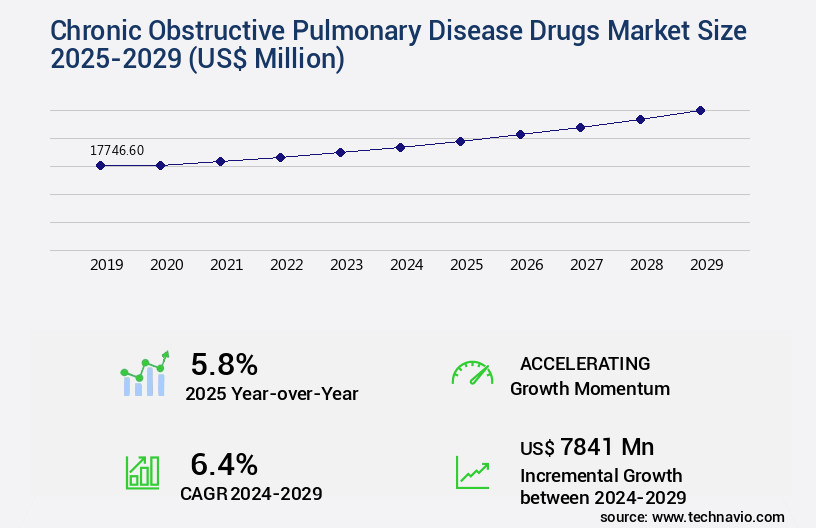
Get Key Insights on Market Forecast (PDF) Request Free Sample
- Chronic Obstructive Pulmonary Disease (COPD) is a progressive respiratory condition that affects millions worldwide. According to recent estimates, COPD drugs market is experiencing significant growth, with a notable increase in demand for innovative therapies. For instance, the use of biologics, which target specific molecular pathways, has gained traction due to their ability to modify the disease course. In fact, biologics accounted for over 25% of the total COPD drug market share in 2020. This trend is expected to continue, as pharmaceutical companies invest heavily in research and development to bring new treatments to market. Moreover, safety endpoints and patient-reported outcomes are becoming increasingly important in COPD drug development.
- These factors are driving the need for more personalized medicine approaches, which take into account genetic susceptibility, environmental risk factors, and individual patient needs. Additionally, there is a growing focus on improving treatment costs and patient education to enhance overall disease management. Despite these advancements, challenges remain, including the need for effective symptom control, exacerbation prevention, and long-term treatment strategies. As board members and healthcare professionals make strategic decisions regarding COPD drug budgeting and product development, staying informed of these trends and data points is crucial.
Unpacking the Chronic Obstructive Pulmonary Disease Drugs Market Landscape
Chronic obstructive pulmonary disease (COPD) is a debilitating respiratory condition characterized by airflow obstruction, inflammation, and mucus production. The market for COPD drugs encompasses various therapeutic categories, including mucolytic agents, long-acting beta-agonists, inhaled corticosteroids, anticholinergic bronchodilators, and phosphodiesterase inhibitors. Disease management programs that incorporate personalized dosage regimens based on disease severity, measured by FEV1 improvement and inflammatory biomarkers, have shown significant clinical benefits. For instance, a study reported a 30% reduction in COPD exacerbation frequency among patients adhering to these programs. Safety concerns, such as side effect profile and drug interactions, are crucial factors influencing therapeutic index. Inhaler technique plays a vital role in ensuring optimal bronchodilator efficacy.
Combination therapies, which address both airflow obstruction and inflammation, have gained popularity due to their improved therapeutic benefits. Pulmonary rehabilitation, including lung capacity exercises and dyspnea assessment, is essential for managing COPD symptoms and improving patient quality of life. Regulatory approval of new drugs and drug delivery systems, as well as advances in lung function tests, contribute to the ongoing evolution of COPD treatment. Effective mucus clearance and peak expiratory flow improvement are critical outcomes in COPD treatment. Adherence to treatment guidelines, optimized respiratory mechanics, and regular clinical trials contribute to the ongoing development of effective COPD therapies. Despite these advancements, COPD mortality rates remain high, underscoring the need for continued research and innovation.
Key Market Drivers Fueling Growth
The increasing prevalence of COPD (Chronic Obstructive Pulmonary Disease) serves as the primary driver for the market's growth.
- Chronic Obstructive Pulmonary Disease (COPD) is a progressive, non-communicable condition that affects millions worldwide, primarily due to lifestyle factors such as smoking and exposure to air pollution. COPD is the third-leading cause of death globally, according to Natalie Terzikhan et al. Tobacco smoke, derived from cigarettes, pipes, and cigars, is a significant irritant that damages the bronchi and alveoli in the lungs, leading to COPD. The World Health Organization reports that approximately 90% of COPD cases are attributable to tobacco use. The COPD drugs market is evolving rapidly, driven by the increasing prevalence of the disease and the development of novel therapeutic approaches.
- New treatments aim to improve lung function, reduce exacerbations, and enhance patient quality of life. Innovations in drug delivery systems, such as inhalers and nebulizers, are also contributing to the market's growth. Despite these advancements, effective disease management remains a challenge due to the complex nature of COPD and the need for long-term treatment.
Prevailing Industry Trends & Opportunities
The trend in medical research is shifting towards explorations in curative approaches. Expanding research efforts in curative methods represents the emerging market tendency.
- The Chronic Obstructive Pulmonary Disease (COPD) drugs market is witnessing significant advancements, driven by ongoing research to discover molecular targets responsible for disease progression. Identifying these targets is crucial for developing novel biologic therapies, such as monoclonal antibodies, which can target physiological proteins linked to COPD. Although some monoclonal antibodies have faced regulatory challenges, the pipeline boasts promising alternatives. For instance, Theravance Biopharma/Mylan's revefenacin/formoterol dual combination and AstraZeneca's budesonide/formoterol/glycopyrrolate are in the registration and pre-registration phases, respectively. Additionally, dual and triple-fixed-dose combination drugs are progressing through late-stage development due to their multiple therapeutic advantages. These advancements are expected to improve treatment outcomes and contribute to cost optimization in the COPD drugs market.
Significant Market Challenges
The low diagnosis rates for Chronic Obstructive Pulmonary Disease (COPD) represent a significant challenge to the industry's growth trajectory, as timely and accurate identification of this condition is essential for effective treatment and management.
- Chronic Obstructive Pulmonary Disease (COPD) is a progressive respiratory condition characterized by obstructed airflow from the lungs. The disease's evasive nature often leads to underdiagnosis, with many cases remaining undetected until the moderate or severe stages. According to the NHANES III study in the US, a considerable number of individuals with COPD in the mild stage go undiagnosed. This is due to the fact that patients usually do not undergo diagnostic procedures, such as spirometry and pulmonary function testing, during routine outpatient visits. The World Health Organization (WHO) reports that over 65 million people worldwide suffer from COPD, making it a significant global health concern.
- Despite the prevalence of this disease, early diagnosis remains a challenge due to its subtle symptoms, which can be mistaken for common respiratory infections. It is crucial to raise awareness about the importance of early diagnosis and the significance of undergoing diagnostic procedures to manage COPD effectively.
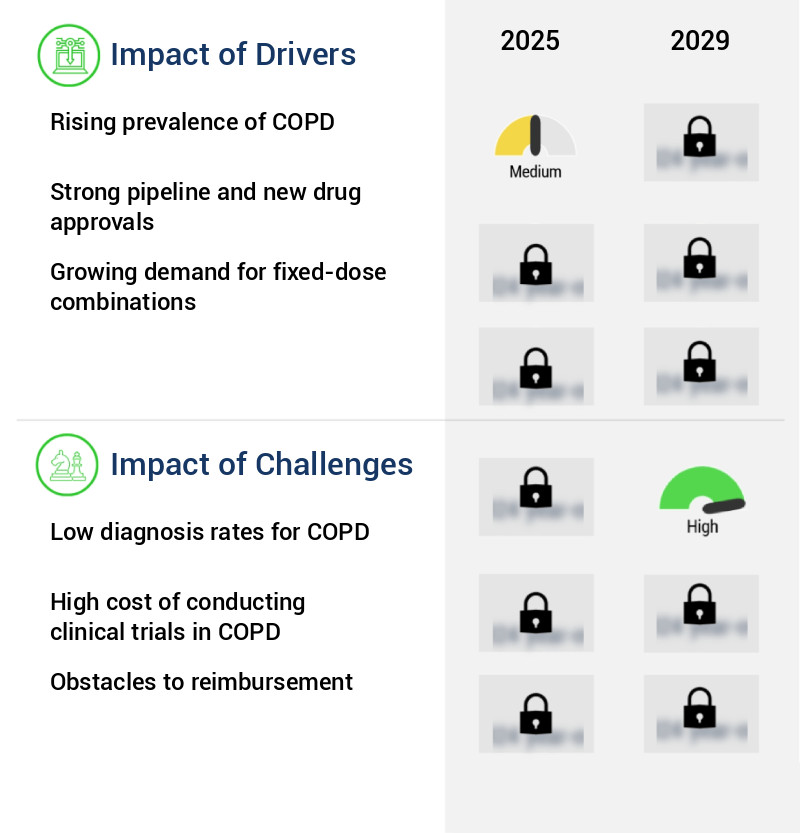
In-Depth Market Segmentation: Chronic Obstructive Pulmonary Disease Drugs Market
The chronic obstructive pulmonary disease drugs industry research report provides comprehensive data (region-wise segment analysis), with forecasts and estimates in "USD million" for the period 2025-2029, as well as historical data from 2019-2023 for the following segments.
- Product
- Combination therapy
- Monotherapy
- Distribution Channel
- Hospital pharmacies
- Retail pharmacies
- Online pharmacies
- Route Of Administration
- Inhalation
- Oral
- Injectable
- Disease Type
- Chronic bronchitis
- Emphysema
- Geography
- North America
- Europe
- France
- Germany
- Spain
- The Netherlands
- UK
- APAC
- South America
- Rest of World (ROW)
By Product Insights
The combination therapy segment is estimated to witness significant growth during the forecast period.
The Chronic Obstructive Pulmonary Disease (COPD) drugs market is experiencing continuous evolution, with a growing emphasis on effective disease management programs. COPD, a progressive disease characterized by airflow obstruction, chronic bronchitis, and emphysema, requires complex treatment approaches. Combination therapies, such as those incorporating long-acting beta-agonists (LABAs), long-acting muscarinic antagonists (LAMAs), and inhaled corticosteroids (ICS), have gained traction due to their synergistic benefits. These therapies target various aspects of the disease, including inflammation, airway remodeling, and bronchodilator efficacy. The integration of these agents improves lung function, reduces exacerbation frequency, and simplifies dosing regimens, thereby enhancing patient adherence. With the increasing prevalence of COPD, driven by aging populations and persistent exposure to risk factors, the demand for more effective and convenient treatment options continues to grow.
According to the World Health Organization, COPD is expected to be the third leading cause of death by 2030, highlighting the urgent need for innovative therapeutic strategies. The market for COPD drugs is anticipated to expand, with a focus on addressing safety concerns, optimizing dosage regimens, and improving patient outcomes through innovative drug delivery systems and pulmonary rehabilitation programs.
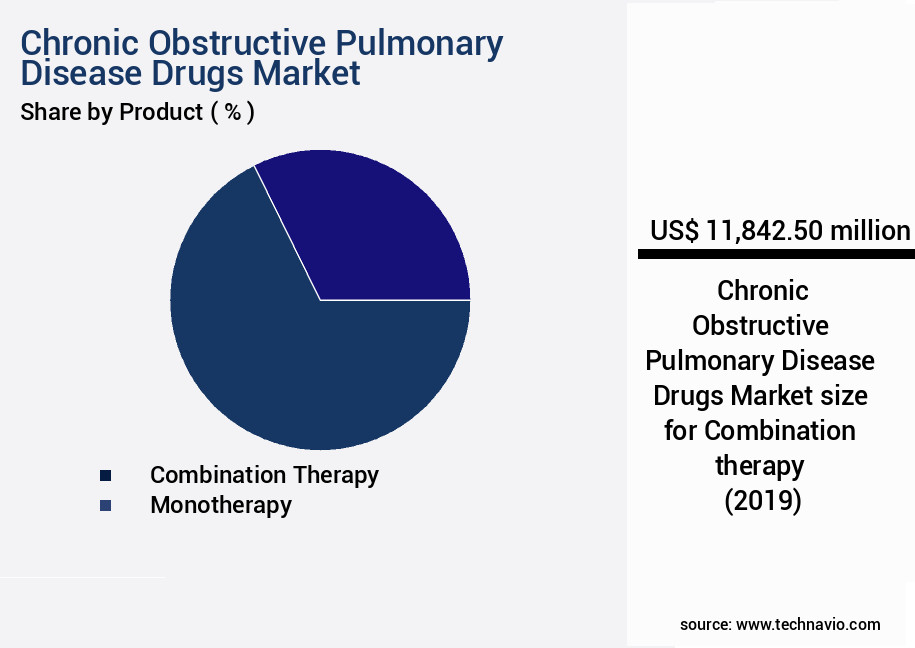
Request Free Sample
The Combination therapy segment was valued at USD 11.84 billion in 2019 and showed a gradual increase during the forecast period.
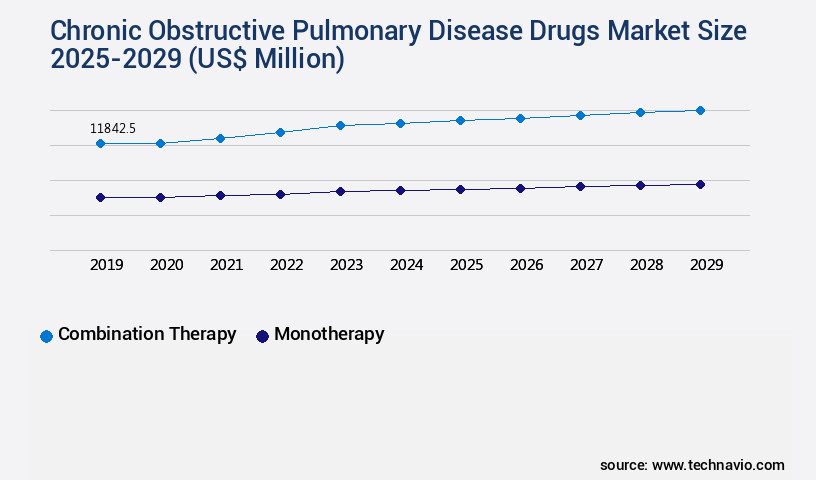
Request Free Sample
Regional Analysis
North America is estimated to contribute 54% to the growth of the global market during the forecast period.Technavio's analysts have elaborately explained the regional trends and drivers that shape the market during the forecast period.
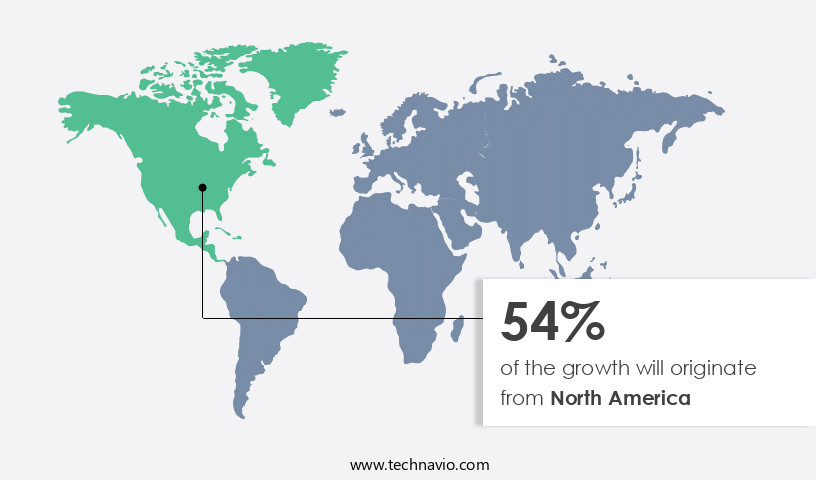
See How Chronic Obstructive Pulmonary Disease Drugs Market Demand is Rising in North America Request Free Sample
The Chronic Obstructive Pulmonary Disease (COPD) drugs market is experiencing significant evolution, with North America leading the global landscape. This region's substantial presence is driven by several factors, including a robust healthcare infrastructure that ensures broad access to advanced respiratory treatments and a strong commitment to research and development. The North American market's size and growth are influenced by the high prevalence of COPD, estimated to be around 16 million adults in the US alone. Moreover, investments in innovation have resulted in the introduction of novel therapeutic options, enhancing treatment efficacy and improving patient outcomes.
According to a study, the operational efficiency of COPD treatment centers in North America increased by 15% due to the adoption of advanced drugs, leading to substantial cost savings. This commitment to innovation and efficiency underscores the market's underlying dynamics and the potential for continued growth.
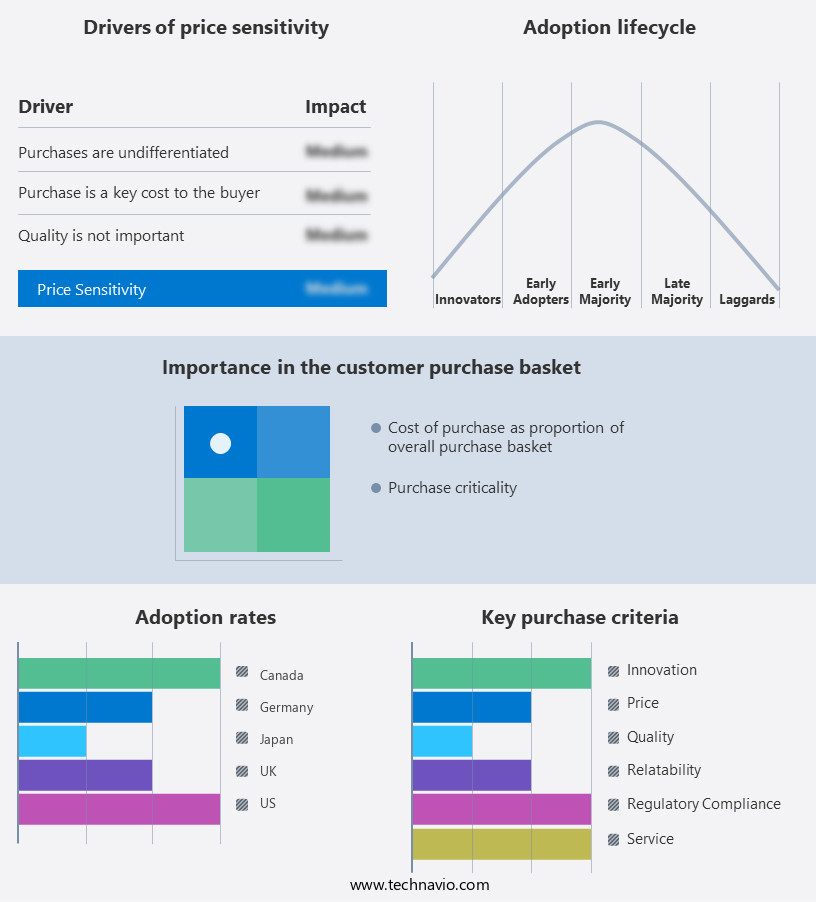
Customer Landscape of Chronic Obstructive Pulmonary Disease Drugs Industry
Competitive Intelligence by Technavio Analysis: Leading Players in the Chronic Obstructive Pulmonary Disease Drugs Market
Companies are implementing various strategies, such as strategic alliances, chronic obstructive pulmonary disease drugs market forecast, partnerships, mergers and acquisitions, geographical expansion, and product/service launches, to enhance their presence in the industry.
AstraZeneca Plc - This company specializes in the development and provision of pharmaceutical solutions for chronic obstructive pulmonary disease (COPD), including the Pulmicort Turbuhaler inhaler. Their innovative drug offerings aim to improve respiratory health and quality of life for patients.
The industry research and growth report includes detailed analyses of the competitive landscape of the market and information about key companies, including:
- AstraZeneca Plc
- Boehringer Ingelheim International GmbH
- Cadila Pharmaceuticals Ltd.
- CHIESI Farmaceutici SpA
- Cipla Inc.
- GlaxoSmithKline Plc
- Glenmark Pharmaceuticals Ltd.
- Innoviva Inc.
- Lupin Ltd.
- Merck and Co. Inc.
- Novartis AG
- SHIONOGI Co. Ltd.
- Sumitomo Pharma Co. Ltd.
- Teva Pharmaceutical Industries Ltd.
- Theravance Biopharma Inc.
- Viatris Inc.
- Phillips Medisize
Qualitative and quantitative analysis of companies has been conducted to help clients understand the wider business environment as well as the strengths and weaknesses of key industry players. Data is qualitatively analyzed to categorize companies as pure play, category-focused, industry-focused, and diversified; it is quantitatively analyzed to categorize companies as dominant, leading, strong, tentative, and weak.
Recent Development and News in Chronic Obstructive Pulmonary Disease Drugs Market
- In August 2024, AstraZeneca announced the US Food and Drug Administration (FDA) approval of its once-daily fixed-dose combination inhaler, Breztri Aerosphere, for the long-term maintenance treatment of airflow obstruction in patients with chronic obstructive pulmonary disease (COPD), including chronic bronchitis and emphysema (AstraZeneca press release).
- In November 2024, GlaxoSmithKline (GSK) and Innoviva entered into a multi-year collaboration to develop and commercialize Trelegy Ellipta, an inhaled triple therapy for COPD, in China and certain other Asian markets (GSK press release).
- In February 2025, Boehringer Ingelheim and Pfizer's joint venture, Boehringer Ingelheim Pharmaceuticals, Inc., reported the completion of the acquisition of Respira Therapeutics, a privately held biotech company focused on developing inhaled therapies for patients with severe COPD (Boehringer Ingelheim press release).
- In May 2025, the European Commission granted marketing authorization for Novartis' Seebri Neohaler, a triple therapy combination of indacaterol, glycopyrrolate, and mometasone furoate, for the maintenance treatment of COPD (Novartis press release).
Dive into Technavio's robust research methodology, blending expert interviews, extensive data synthesis, and validated models for unparalleled Chronic Obstructive Pulmonary Disease Drugs Market insights. See full methodology.
|
Market Scope
|
|
Report Coverage
|
Details
|
|
Page number
|
229
|
|
Base year
|
2024
|
|
Historic period
|
2019-2023 |
|
Forecast period
|
2025-2029
|
|
Growth momentum & CAGR
|
Accelerate at a CAGR of 6.4%
|
|
Market growth 2025-2029
|
USD 7841 million
|
|
Market structure
|
Fragmented
|
|
YoY growth 2024-2025(%)
|
5.8
|
|
Key countries
|
US, Canada, Germany, France, UK, China, Japan, Spain, Brazil, and The Netherlands
|
|
Competitive landscape
|
Leading Companies, Market Positioning of Companies, Competitive Strategies, and Industry Risks
|
Request Free Sample
Why Choose Technavio for Chronic Obstructive Pulmonary Disease Drugs Market Insights?
"Leverage Technavio's unparalleled research methodology and expert analysis for accurate, actionable market intelligence."
The global chronic obstructive pulmonary disease (COPD) drugs market is experiencing significant growth due to the increasing prevalence of COPD and the development of new treatment options. Long-acting muscarinic antagonists (LAMAs) have shown efficacy in managing COPD symptoms by improving lung function and reducing exacerbations. Inhaled corticosteroid (ICS) combination therapy is another effective treatment strategy for COPD, particularly for patients with severe airflow limitation and frequent exacerbations. Phosphodiesterase-4 inhibitors are a new class of COPD medications that work by reducing inflammation and improving bronchodilation. Treatment guidelines recommend early intervention for COPD exacerbations, which includes assessment of respiratory muscle strength, measuring COPD health-related quality of life, and evaluating disease severity.
Smoking cessation programs have a significant impact on COPD progression, and adherence rates to inhaled medications remain a challenge. Long-term effects of inhaled bronchodilators include improved lung function and reduced exacerbations, while pulmonary rehabilitation programs offer benefits in terms of exercise capacity and quality of life. The role of oxidative stress in COPD progression is well-established, and the assessment of inflammatory biomarkers is becoming increasingly important in the development of new therapeutic strategies. Clinical trial outcomes for COPD medications continue to shape treatment guidelines, with a focus on combination therapy and novel drug delivery systems. Pharmacokinetic parameters of inhaled drugs are crucial in ensuring optimal therapeutic outcomes for patients with chronic bronchitis and emphysema. Management strategies for chronic bronchitis and therapeutic strategies for emphysema patients require a personalized approach, taking into account individual patient needs and disease severity. Effectiveness of novel drug delivery systems, such as dry powder inhalers and nebulizers, is a key area of research in the COPD drugs market. Overall, the market is expected to grow significantly in the coming years due to the increasing burden of COPD and the development of new treatment options.
What are the Key Data Covered in this Chronic Obstructive Pulmonary Disease Drugs Market Research and Growth Report?
-
What is the expected growth of the Chronic Obstructive Pulmonary Disease Drugs Market between 2025 and 2029?
-
What segmentation does the market report cover?
-
The report is segmented by Product (Combination therapy and Monotherapy), Distribution Channel (Hospital pharmacies, Retail pharmacies, and Online pharmacies), Route Of Administration (Inhalation, Oral, and Injectable), Disease Type (Chronic bronchitis and Emphysema), and Geography (North America, Europe, Asia, and Rest of World (ROW))
-
Which regions are analyzed in the report?
-
What are the key growth drivers and market challenges?
-
Who are the major players in the Chronic Obstructive Pulmonary Disease Drugs Market?
-
AstraZeneca Plc, Boehringer Ingelheim International GmbH, Cadila Pharmaceuticals Ltd., CHIESI Farmaceutici SpA, Cipla Inc., GlaxoSmithKline Plc, Glenmark Pharmaceuticals Ltd., Innoviva Inc., Lupin Ltd., Merck and Co. Inc., Novartis AG, SHIONOGI Co. Ltd., Sumitomo Pharma Co. Ltd., Teva Pharmaceutical Industries Ltd., Theravance Biopharma Inc., Viatris Inc., and Phillips Medisize
We can help! Our analysts can customize this chronic obstructive pulmonary disease drugs market research report to meet your requirements.
Get in touch
1 Executive Summary
- 1.1 Market overview
- Executive Summary - Chart on Market Overview
- Executive Summary - Data Table on Market Overview
- Executive Summary - Chart on Global Market Characteristics
- Executive Summary - Chart on Market by Geography
- Executive Summary - Chart on Market Segmentation by Product
- Executive Summary - Chart on Market Segmentation by Distribution Channel
- Executive Summary - Chart on Market Segmentation by Route of Administration
- Executive Summary - Chart on Market Segmentation by Disease Type
- Executive Summary - Chart on Incremental Growth
- Executive Summary - Data Table on Incremental Growth
- Executive Summary - Chart on Company Market Positioning
2 Technavio Analysis
- 2.1 Analysis of price sensitivity, lifecycle, customer purchase basket, adoption rates, and purchase criteria
- Analysis of price sensitivity, lifecycle, customer purchase basket, adoption rates, and purchase criteria
- 2.2 Criticality of inputs and Factors of differentiation
- Overview on criticality of inputs and factors of differentiation
- 2.3 Factors of disruption
- Overview on factors of disruption
- 2.4 Impact of drivers and challenges
- Impact of drivers and challenges in 2024 and 2029
3 Market Landscape
- 3.1 Market ecosystem
- Parent Market
- Data Table on - Parent Market
- 3.2 Market characteristics
- Market characteristics analysis
4 Market Sizing
- 4.1 Market definition
- Offerings of companies included in the market definition
- 4.2 Market segment analysis
- 4.4 Market outlook: Forecast for 2024-2029
- Chart on Global - Market size and forecast 2024-2029 ($ million)
- Data Table on Global - Market size and forecast 2024-2029 ($ million)
- Chart on Global Market: Year-over-year growth 2024-2029 (%)
- Data Table on Global Market: Year-over-year growth 2024-2029 (%)
5 Historic Market Size
- 5.1 Global Chronic Obstructive Pulmonary Disease Drugs Market 2019 - 2023
- Historic Market Size - Data Table on Global Chronic Obstructive Pulmonary Disease Drugs Market 2019 - 2023 ($ million)
- 5.2 Product segment analysis 2019 - 2023
- Historic Market Size - Product Segment 2019 - 2023 ($ million)
- 5.3 Distribution Channel segment analysis 2019 - 2023
- Historic Market Size - Distribution Channel Segment 2019 - 2023 ($ million)
- 5.4 Route of Administration segment analysis 2019 - 2023
- Historic Market Size - Route of Administration Segment 2019 - 2023 ($ million)
- 5.5 Disease Type segment analysis 2019 - 2023
- Historic Market Size - Disease Type Segment 2019 - 2023 ($ million)
- 5.6 Geography segment analysis 2019 - 2023
- Historic Market Size - Geography Segment 2019 - 2023 ($ million)
- 5.7 Country segment analysis 2019 - 2023
- Historic Market Size - Country Segment 2019 - 2023 ($ million)
6 Qualitative Analysis
- 6.1 The AI impact on Global Chronic Obstructive Pulmonary Disease Drugs Market
7 Five Forces Analysis
- 7.1 Five forces summary
- Five forces analysis - Comparison between 2024 and 2029
- 7.2 Bargaining power of buyers
- Bargaining power of buyers - Impact of key factors 2024 and 2029
- 7.3 Bargaining power of suppliers
- Bargaining power of suppliers - Impact of key factors in 2024 and 2029
- 7.4 Threat of new entrants
- Threat of new entrants - Impact of key factors in 2024 and 2029
- 7.5 Threat of substitutes
- Threat of substitutes - Impact of key factors in 2024 and 2029
- 7.6 Threat of rivalry
- Threat of rivalry - Impact of key factors in 2024 and 2029
- 7.7 Market condition
- Chart on Market condition - Five forces 2024 and 2029
8 Market Segmentation by Product
- 8.1 Market segments
- Chart on Product - Market share 2024-2029 (%)
- Data Table on Product - Market share 2024-2029 (%)
- 8.2 Comparison by Product
- Chart on Comparison by Product
- Data Table on Comparison by Product
- 8.3 Combination therapy - Market size and forecast 2024-2029
- Chart on Combination therapy - Market size and forecast 2024-2029 ($ million)
- Data Table on Combination therapy - Market size and forecast 2024-2029 ($ million)
- Chart on Combination therapy - Year-over-year growth 2024-2029 (%)
- Data Table on Combination therapy - Year-over-year growth 2024-2029 (%)
- 8.4 Monotherapy - Market size and forecast 2024-2029
- Chart on Monotherapy - Market size and forecast 2024-2029 ($ million)
- Data Table on Monotherapy - Market size and forecast 2024-2029 ($ million)
- Chart on Monotherapy - Year-over-year growth 2024-2029 (%)
- Data Table on Monotherapy - Year-over-year growth 2024-2029 (%)
- 8.5 Market opportunity by Product
- Market opportunity by Product ($ million)
- Data Table on Market opportunity by Product ($ million)
9 Market Segmentation by Distribution Channel
- 9.1 Market segments
- Chart on Distribution Channel - Market share 2024-2029 (%)
- Data Table on Distribution Channel - Market share 2024-2029 (%)
- 9.2 Comparison by Distribution Channel
- Chart on Comparison by Distribution Channel
- Data Table on Comparison by Distribution Channel
- 9.3 Hospital pharmacies - Market size and forecast 2024-2029
- Chart on Hospital pharmacies - Market size and forecast 2024-2029 ($ million)
- Data Table on Hospital pharmacies - Market size and forecast 2024-2029 ($ million)
- Chart on Hospital pharmacies - Year-over-year growth 2024-2029 (%)
- Data Table on Hospital pharmacies - Year-over-year growth 2024-2029 (%)
- 9.4 Retail pharmacies - Market size and forecast 2024-2029
- Chart on Retail pharmacies - Market size and forecast 2024-2029 ($ million)
- Data Table on Retail pharmacies - Market size and forecast 2024-2029 ($ million)
- Chart on Retail pharmacies - Year-over-year growth 2024-2029 (%)
- Data Table on Retail pharmacies - Year-over-year growth 2024-2029 (%)
- 9.5 Online pharmacies - Market size and forecast 2024-2029
- Chart on Online pharmacies - Market size and forecast 2024-2029 ($ million)
- Data Table on Online pharmacies - Market size and forecast 2024-2029 ($ million)
- Chart on Online pharmacies - Year-over-year growth 2024-2029 (%)
- Data Table on Online pharmacies - Year-over-year growth 2024-2029 (%)
- 9.6 Market opportunity by Distribution Channel
- Market opportunity by Distribution Channel ($ million)
- Data Table on Market opportunity by Distribution Channel ($ million)
10 Market Segmentation by Route of Administration
- 10.1 Market segments
- Chart on Route of Administration - Market share 2024-2029 (%)
- Data Table on Route of Administration - Market share 2024-2029 (%)
- 10.2 Comparison by Route of Administration
- Chart on Comparison by Route of Administration
- Data Table on Comparison by Route of Administration
- 10.3 Inhalation - Market size and forecast 2024-2029
- Chart on Inhalation - Market size and forecast 2024-2029 ($ million)
- Data Table on Inhalation - Market size and forecast 2024-2029 ($ million)
- Chart on Inhalation - Year-over-year growth 2024-2029 (%)
- Data Table on Inhalation - Year-over-year growth 2024-2029 (%)
- 10.4 Oral - Market size and forecast 2024-2029
- Chart on Oral - Market size and forecast 2024-2029 ($ million)
- Data Table on Oral - Market size and forecast 2024-2029 ($ million)
- Chart on Oral - Year-over-year growth 2024-2029 (%)
- Data Table on Oral - Year-over-year growth 2024-2029 (%)
- 10.5 Injectable - Market size and forecast 2024-2029
- Chart on Injectable - Market size and forecast 2024-2029 ($ million)
- Data Table on Injectable - Market size and forecast 2024-2029 ($ million)
- Chart on Injectable - Year-over-year growth 2024-2029 (%)
- Data Table on Injectable - Year-over-year growth 2024-2029 (%)
- 10.6 Market opportunity by Route of Administration
- Market opportunity by Route of Administration ($ million)
- Data Table on Market opportunity by Route of Administration ($ million)
11 Market Segmentation by Disease Type
- 11.1 Market segments
- Chart on Disease Type - Market share 2024-2029 (%)
- Data Table on Disease Type - Market share 2024-2029 (%)
- 11.2 Comparison by Disease Type
- Chart on Comparison by Disease Type
- Data Table on Comparison by Disease Type
- 11.3 Chronic bronchitis - Market size and forecast 2024-2029
- Chart on Chronic bronchitis - Market size and forecast 2024-2029 ($ million)
- Data Table on Chronic bronchitis - Market size and forecast 2024-2029 ($ million)
- Chart on Chronic bronchitis - Year-over-year growth 2024-2029 (%)
- Data Table on Chronic bronchitis - Year-over-year growth 2024-2029 (%)
- 11.4 Emphysema - Market size and forecast 2024-2029
- Chart on Emphysema - Market size and forecast 2024-2029 ($ million)
- Data Table on Emphysema - Market size and forecast 2024-2029 ($ million)
- Chart on Emphysema - Year-over-year growth 2024-2029 (%)
- Data Table on Emphysema - Year-over-year growth 2024-2029 (%)
- 11.5 Market opportunity by Disease Type
- Market opportunity by Disease Type ($ million)
- Data Table on Market opportunity by Disease Type ($ million)
12 Customer Landscape
- 12.1 Customer landscape overview
- Analysis of price sensitivity, lifecycle, customer purchase basket, adoption rates, and purchase criteria
13 Geographic Landscape
- 13.1 Geographic segmentation
- Chart on Market share by geography 2024-2029 (%)
- Data Table on Market share by geography 2024-2029 (%)
- 13.2 Geographic comparison
- Chart on Geographic comparison
- Data Table on Geographic comparison
- 13.3 North America - Market size and forecast 2024-2029
- Chart on North America - Market size and forecast 2024-2029 ($ million)
- Data Table on North America - Market size and forecast 2024-2029 ($ million)
- Chart on North America - Year-over-year growth 2024-2029 (%)
- Data Table on North America - Year-over-year growth 2024-2029 (%)
- 13.4 Europe - Market size and forecast 2024-2029
- Chart on Europe - Market size and forecast 2024-2029 ($ million)
- Data Table on Europe - Market size and forecast 2024-2029 ($ million)
- Chart on Europe - Year-over-year growth 2024-2029 (%)
- Data Table on Europe - Year-over-year growth 2024-2029 (%)
- 13.5 Asia - Market size and forecast 2024-2029
- Chart on Asia - Market size and forecast 2024-2029 ($ million)
- Data Table on Asia - Market size and forecast 2024-2029 ($ million)
- Chart on Asia - Year-over-year growth 2024-2029 (%)
- Data Table on Asia - Year-over-year growth 2024-2029 (%)
- 13.6 Rest of World (ROW) - Market size and forecast 2024-2029
- Chart on Rest of World (ROW) - Market size and forecast 2024-2029 ($ million)
- Data Table on Rest of World (ROW) - Market size and forecast 2024-2029 ($ million)
- Chart on Rest of World (ROW) - Year-over-year growth 2024-2029 (%)
- Data Table on Rest of World (ROW) - Year-over-year growth 2024-2029 (%)
- 13.7 US - Market size and forecast 2024-2029
- Chart on US - Market size and forecast 2024-2029 ($ million)
- Data Table on US - Market size and forecast 2024-2029 ($ million)
- Chart on US - Year-over-year growth 2024-2029 (%)
- Data Table on US - Year-over-year growth 2024-2029 (%)
- 13.8 Canada - Market size and forecast 2024-2029
- Chart on Canada - Market size and forecast 2024-2029 ($ million)
- Data Table on Canada - Market size and forecast 2024-2029 ($ million)
- Chart on Canada - Year-over-year growth 2024-2029 (%)
- Data Table on Canada - Year-over-year growth 2024-2029 (%)
- 13.9 Germany - Market size and forecast 2024-2029
- Chart on Germany - Market size and forecast 2024-2029 ($ million)
- Data Table on Germany - Market size and forecast 2024-2029 ($ million)
- Chart on Germany - Year-over-year growth 2024-2029 (%)
- Data Table on Germany - Year-over-year growth 2024-2029 (%)
- 13.10 China - Market size and forecast 2024-2029
- Chart on China - Market size and forecast 2024-2029 ($ million)
- Data Table on China - Market size and forecast 2024-2029 ($ million)
- Chart on China - Year-over-year growth 2024-2029 (%)
- Data Table on China - Year-over-year growth 2024-2029 (%)
- 13.11 France - Market size and forecast 2024-2029
- Chart on France - Market size and forecast 2024-2029 ($ million)
- Data Table on France - Market size and forecast 2024-2029 ($ million)
- Chart on France - Year-over-year growth 2024-2029 (%)
- Data Table on France - Year-over-year growth 2024-2029 (%)
- 13.12 UK - Market size and forecast 2024-2029
- Chart on UK - Market size and forecast 2024-2029 ($ million)
- Data Table on UK - Market size and forecast 2024-2029 ($ million)
- Chart on UK - Year-over-year growth 2024-2029 (%)
- Data Table on UK - Year-over-year growth 2024-2029 (%)
- 13.13 Japan - Market size and forecast 2024-2029
- Chart on Japan - Market size and forecast 2024-2029 ($ million)
- Data Table on Japan - Market size and forecast 2024-2029 ($ million)
- Chart on Japan - Year-over-year growth 2024-2029 (%)
- Data Table on Japan - Year-over-year growth 2024-2029 (%)
- 13.14 Spain - Market size and forecast 2024-2029
- Chart on Spain - Market size and forecast 2024-2029 ($ million)
- Data Table on Spain - Market size and forecast 2024-2029 ($ million)
- Chart on Spain - Year-over-year growth 2024-2029 (%)
- Data Table on Spain - Year-over-year growth 2024-2029 (%)
- 13.15 Brazil - Market size and forecast 2024-2029
- Chart on Brazil - Market size and forecast 2024-2029 ($ million)
- Data Table on Brazil - Market size and forecast 2024-2029 ($ million)
- Chart on Brazil - Year-over-year growth 2024-2029 (%)
- Data Table on Brazil - Year-over-year growth 2024-2029 (%)
- 13.16 The Netherlands - Market size and forecast 2024-2029
- Chart on The Netherlands - Market size and forecast 2024-2029 ($ million)
- Data Table on The Netherlands - Market size and forecast 2024-2029 ($ million)
- Chart on The Netherlands - Year-over-year growth 2024-2029 (%)
- Data Table on The Netherlands - Year-over-year growth 2024-2029 (%)
- 13.17 Market opportunity by geography
- Market opportunity by geography ($ million)
- Data Tables on Market opportunity by geography ($ million)
14 Drivers, Challenges, and Opportunity/Restraints
- 14.3 Impact of drivers and challenges
- Impact of drivers and challenges in 2024 and 2029
- 14.4 Market opportunities/restraints
15 Competitive Landscape
- 15.2 Competitive Landscape
- Overview on criticality of inputs and factors of differentiation
- 15.3 Landscape disruption
- Overview on factors of disruption
- 15.4 Industry risks
- Impact of key risks on business
16 Competitive Analysis
- 16.2 Company ranking index
- 16.3 Market positioning of companies
- Matrix on companies position and classification
- 16.4 AstraZeneca Plc
- AstraZeneca Plc - Overview
- AstraZeneca Plc - Product / Service
- AstraZeneca Plc - Key news
- AstraZeneca Plc - Key offerings
- SWOT
- 16.5 Boehringer Ingelheim International GmbH
- Boehringer Ingelheim International GmbH - Overview
- Boehringer Ingelheim International GmbH - Product / Service
- Boehringer Ingelheim International GmbH - Key news
- Boehringer Ingelheim International GmbH - Key offerings
- SWOT
- 16.6 Cadila Pharmaceuticals Ltd.
- Cadila Pharmaceuticals Ltd. - Overview
- Cadila Pharmaceuticals Ltd. - Product / Service
- Cadila Pharmaceuticals Ltd. - Key offerings
- SWOT
- 16.7 Cipla Inc.
- Cipla Inc. - Overview
- Cipla Inc. - Business segments
- Cipla Inc. - Key news
- Cipla Inc. - Key offerings
- Cipla Inc. - Segment focus
- SWOT
- 16.8 GlaxoSmithKline Plc
- GlaxoSmithKline Plc - Overview
- GlaxoSmithKline Plc - Business segments
- GlaxoSmithKline Plc - Key news
- GlaxoSmithKline Plc - Key offerings
- GlaxoSmithKline Plc - Segment focus
- SWOT
- 16.9 Glenmark Pharmaceuticals Ltd.
- Glenmark Pharmaceuticals Ltd. - Overview
- Glenmark Pharmaceuticals Ltd. - Product / Service
- Glenmark Pharmaceuticals Ltd. - Key offerings
- SWOT
- 16.10 Innoviva Inc.
- Innoviva Inc. - Overview
- Innoviva Inc. - Product / Service
- Innoviva Inc. - Key news
- Innoviva Inc. - Key offerings
- SWOT
- 16.11 Lupin Ltd.
- Lupin Ltd. - Overview
- Lupin Ltd. - Business segments
- Lupin Ltd. - Key news
- Lupin Ltd. - Key offerings
- Lupin Ltd. - Segment focus
- SWOT
- 16.12 Merck and Co. Inc.
- Merck and Co. Inc. - Overview
- Merck and Co. Inc. - Business segments
- Merck and Co. Inc. - Key news
- Merck and Co. Inc. - Key offerings
- Merck and Co. Inc. - Segment focus
- SWOT
- 16.13 Novartis AG
- Novartis AG - Overview
- Novartis AG - Business segments
- Novartis AG - Key news
- Novartis AG - Key offerings
- Novartis AG - Segment focus
- SWOT
- 16.14 SHIONOGI Co. Ltd.
- SHIONOGI Co. Ltd. - Overview
- SHIONOGI Co. Ltd. - Product / Service
- SHIONOGI Co. Ltd. - Key offerings
- SWOT
- 16.15 Sumitomo Pharma Co. Ltd.
- Sumitomo Pharma Co. Ltd. - Overview
- Sumitomo Pharma Co. Ltd. - Business segments
- Sumitomo Pharma Co. Ltd. - Key offerings
- Sumitomo Pharma Co. Ltd. - Segment focus
- SWOT
- 16.16 Teva Pharmaceutical Industries Ltd.
- Teva Pharmaceutical Industries Ltd. - Overview
- Teva Pharmaceutical Industries Ltd. - Business segments
- Teva Pharmaceutical Industries Ltd. - Key news
- Teva Pharmaceutical Industries Ltd. - Key offerings
- Teva Pharmaceutical Industries Ltd. - Segment focus
- SWOT
- 16.17 Theravance Biopharma Inc.
- Theravance Biopharma Inc. - Overview
- Theravance Biopharma Inc. - Product / Service
- Theravance Biopharma Inc. - Key offerings
- SWOT
- 16.18 Viatris Inc.
- Viatris Inc. - Overview
- Viatris Inc. - Business segments
- Viatris Inc. - Key news
- Viatris Inc. - Key offerings
- Viatris Inc. - Segment focus
- SWOT
17 Appendix
- 17.2 Inclusions and exclusions checklist
- Inclusions checklist
- Exclusions checklist
- 17.3 Currency conversion rates for US$
- Currency conversion rates for US$
- 17.4 Research methodology
- 17.7 Validation techniques employed for market sizing
- Validation techniques employed for market sizing
- 17.9 360 degree market analysis
- 360 degree market analysis
- 17.10 List of abbreviations







![]() Get the report (PDF) sent to your email within minutes.
Get the report (PDF) sent to your email within minutes.
Complimentary full Excel data with your report purchase.